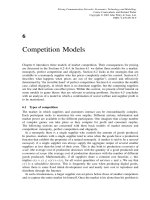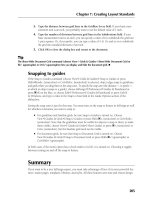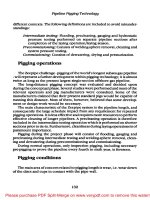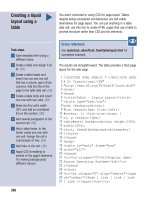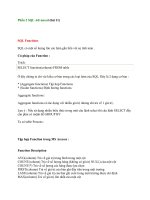Tài liệu SQL Puzzles & Answers- P6 ppt
Bạn đang xem bản rút gọn của tài liệu. Xem và tải ngay bản đầy đủ của tài liệu tại đây (369.56 KB, 40 trang )
182 PUZZLE 44 PAIRS OF STYLES
Answer #3
But the best way is to update the database itself and make item_a the
smallest of the two code numbers, before doing the query, so this is not
an issue:
UPDATE SalesSlips
SET item_a = item_b,
item_b = item_a
WHERE item_a > item_b;
You could also do this with a TRIGGER on insertion, but that would
mean writing proprietary procedural code. The real answer is to mop the
floor (these updates) and then to fix the leak with a
CHECK() constraint:
CREATE TABLE SalesSlips
(item_a INTEGER NOT NULL,
item_b INTEGER NOT NULL,
PRIMARY KEY(item_a, item_b),
CHECK (item_a <= item_b)
pair_tally INTEGER NOT NULL);
Please purchase PDF Split-Merge on www.verypdf.com to remove this watermark.
PUZZLE 45 PEPPERONI PIZZA 183
PUZZLE
45 PEPPERONI PIZZA
A good classic accounting problem is to print an aging report of old
billings. Let’s use the Friends of Pepperoni, who have a charge card at
our pizza joint. It would be nice to find out if you should have let club
members charge pizza on their cards.
You have a table of charges that contains a member identification
number (
cust_id), a date (bill_date), and an amount (pizza_amt).
None of these is a key, so there can be multiple entries for a customer,
with various dates and amounts. This is an old-fashioned journal file,
done as an SQL table.
What you are trying to do is get a sum of amounts paid by each
member within an age range. The ranges are 0 to 30 days old, 31 to 60
days old, 61 to 90 days old, and everything over 90 days old. This is
called an aging report on account receivables, and you use it to see what
the Friends of Pepperoni program is doing to you.
Answer #1
You can write a query for each age range with UNION ALL operators,
like this:
SELECT cust_id, '0-30 days = ' AS age, SUM (pizza_amt)
FROM Friends Of Pepperoni
WHERE bill_date BETWEEN CURRENT_DATE
AND (CURRENT_DATE - INTERVAL 30 DAY)
GROUP BY cust_id
UNION ALL
SELECT cust_id, '31-60 days = ' AS age, SUM (pizza_amt)
FROM FriendsOfPepperoni
WHERE bill_date BETWEEN (CURRENT_DATE - INTERVAL 31 DAY)
AND (CURRENT_DATE - INTERVAL 90 DAY)
GROUP BY cust_id
UNION ALL
SELECT cust_id, '61-90 days = ' AS age, SUM(pizza_amt)
FROM FriendsOfPepperoni
WHERE bill_date BETWEEN (CURRENT_DATE - INTERVAL 61 DAY)
AND (CURRENT_DATE - INTERVAL 90 DAY)
GROUP BY cust_id
UNION ALL
Please purchase PDF Split-Merge on www.verypdf.com to remove this watermark.
184 PUZZLE 45 PEPPERONI PIZZA
SELECT cust_id, '90+ days = ' AS age, SUM(pizza_amt)
FROM FriendsOfPepperoni
WHERE bill_date < CURRENT_DATE - INTERVAL 90 DAY) GROUP BY
cust_id
ORDER BY cust_id, age;
Using the second column to keep the age ranges as text makes sorting
within each customer easier because the strings are in temporal order.
This query works, but it takes awhile. There must be a better way to do
this in SQL-92.
Answer #2
Do not use UNIONs when you can use a CASE expression instead. The
UNIONs will make multiple passes over the table, and the CASE expression
will make only one.
SELECT cust_id,
SUM(CASE WHEN bill_date
BETWEEN CURRENT_TIMESTAMP - INTERVAL 30 DAYS
AND CURRENT_TIMESTAMP
THEN pizza_amt ELSE 0.00) AS age1,
SUM(CASE WHEN bill_date
BETWEEN CURRENT_TIMESTAMP - INTERVAL 60 DAYS
AND CURRENT_TIMESTAMP - INTERVAL 31 DAYS
THEN pizza_amt ELSE 0.00) AS age2,
SUM(CASE WHEN bill_date
BETWEEN CURRENT_TIMESTAMP - INTERVAL 90 DAYS
AND CURRENT_TIMESTAMP - INTERVAL 61
DAYS
THEN pizza_amt ELSE 0.00) AS age3,
SUM(CASE WHEN bill_date
< CURRENT_TIMESTAMP - INTERVAL 91 DAYS
THEN pizza_amt ELSE 0.00) AS age4
FROM FriendsofPepperoni;
Using the CASE expression to replace UNIONs is a handy trick.
Answer #3
You can avoid both UNIONs and CASE expressions by creating a CTE or
derived table with the ranges for the report.
Please purchase PDF Split-Merge on www.verypdf.com to remove this watermark.
PUZZLE 45 PEPPERONI PIZZA 185
WITH ReportRanges(day_count, start_cnt, end_cnt)
AS (VALUES ('under Thirty days', 00, 30),
('Sixty days', 31, 60),
('Ninty days', 61, 90))
SELECT F1.cust_id, R1.day_count, SUM(pizza_amt)
FROM FriendsofPepperoni AS F1
LEFT OUTER JOIN
ReportRanges AS R1
ON F1.bill_date
BETWEEN CURRENT_TIMESTAMP - start_cnt DAY
AND CURRENT_TIMESTAMP - end_cnt DAY;
This is easier to maintain and extend than the CASE expression. It can
also be faster with indexing. Remember, SQL is designed for joins and
not computations.
Please purchase PDF Split-Merge on www.verypdf.com to remove this watermark.
186 PUZZLE 46 SALES PROMOTIONS
PUZZLE
46 SALES PROMOTIONS
You have just gotten a job as the sales manager for a department store.
Your database has two tables. One is a calendar of the promotional
events the store has had, and the other is a list of the sales that have been
made during the promotions. You need to write a query that will tell us
which clerk had the highest amount of sales for each promotion, so we
can pay that clerk a performance bonus.
CREATE TABLE Promotions
(promo_name CHAR(25) NOT NULL PRIMARY KEY,
start_date DATE NOT NULL,
end_date DATE NOT NULL,
CHECK (start_date <= end_date));
Promotions
promo_name start_date end_date
=====================================================
'Feast of St. Fred' '1995-02-01' '1995-02-07'
'National Pickle Pageant' '1995-11-01' '1995-11-07'
'Christmas Week' '1995-12-18' '1995-12-25'
CREATE TABLE Sales
(ticket_nbr INTEGER NOT NULL PRIMARY KEY,
clerk_name CHAR (15) NOT NULL,
sale_date DATE NOT NULL,
sale_amt DECIMAL (8,2) NOT NULL);
Answer #1
The trick in this query is that we need to find out what each employee
sold during each promo and finally pick the highest sum from those
groups. The first part is a fairly easy
JOIN and GROUP BY statement.
The final step of finding the largest total sales in each grouping
requires a fairly tricky
HAVING clause. Let’s look at the answer first, and
then explain it.
SELECT S1.clerk_name, P1.promo_name, SUM(S1.amount) AS
sales_tot
FROM Sales AS S1, Promotions AS P1
Please purchase PDF Split-Merge on www.verypdf.com to remove this watermark.
PUZZLE 46 SALES PROMOTIONS 187
WHERE S1.saledate BETWEEN P1.start_date AND P1.end_date
GROUP BY S1.clerk_name, P1.promo_name
HAVING SUM(amount) >=
ALL (SELECT SUM(amount)
FROM Sales AS S2
WHERE S2.clerk_name <> S1.clerk_name
AND S2.saledate
BETWEEN (SELECT start_date
FROM Promotions AS P2
WHERE P2.promo_name =
P1.promo_name)
AND (SELECT end_date
FROM Promotions AS P3
WHERE P3.promo_name =
P1.promo_name)
GROUP BY S2.clerk_name);
We want the total sales for the chosen clerk and promotion to be
equal or greater than the other total sales of all the other clerks during
that promotion. The predicate “
S2.clerk_name <> S1.clerk_name”
excludes the other clerks from the subquery total. The subquery
expressions in the
BETWEEN predicate make sure that we are using the
right dates for the promotion.
The first thought when trying to improve this query is to replace the
subquery expressions in the
BETWEEN predicate with direct outer
references, like this:
SELECT S1.clerk_name, P1.promo_name, SUM(S1.amount) AS
sales_tot
FROM Sales AS S1 Promotions AS P1
WHERE S1.saledate BETWEEN P1.start_date AND P1.end_date
GROUP BY S1.clerk_name, P1.promo_name
HAVING SUM(amount) >=
ALL (SELECT SUM(amount)
FROM Sales AS S2
WHERE S2.clerk_name <> S1.clerk_name
AND S2.saledate Error !!
BETWEEN P1.start_date AND P1.end_date
GROUP BY S2.clerk_name);
Please purchase PDF Split-Merge on www.verypdf.com to remove this watermark.
188 PUZZLE 46 SALES PROMOTIONS
But this will not work—and if you know why, then you really know
your SQL. Cover the rest of this page and try to figure it out before you
read further.
Answer #2
The “GROUP BY S1.clerk_name, P1.promo_name” clause has created a
grouped table whose rows contain only aggregate functions and two
grouping columns. The original working table built in the
FROM clause
ceased to exist and was replaced by this grouped working table, so the
start_date and end_date also ceased to exist at that point.
However, the subquery expressions work because they reference the
outer table
P1 while it is still available, since the query works from the
innermost subqueries outward and not the grouped table.
If we were looking for sales performance between two known,
constant dates, then the second query would work when we replaced
P1.start_date and P1.end_date with those constants.
Two readers of my column sent in improved versions of this puzzle.
Richard Romley and J. D. McDonald both noticed that the Promotions
table has only key columns if we assume that no promotions overlap, so
that using (
promo_name, start_date, end_date) in the GROUP BY clause
will not change the grouping. However, it will make the
start_date and
end_date available to the HAVING clause, thus:
SELECT S1.clerk_name, P1.promo_name, SUM(S1.amount) AS sales_tot
FROM Sales AS S1 Promotions AS P1
WHERE S1.saledate BETWEEN P1.start_date AND P1.end_date
GROUP BY P1.promo_name, P1.start_date, P1.end_date,
S1.clerk_name
HAVING SUM(S1.amount) >
ALL (SELECT SUM(S2.amount)
FROM Sales AS S2
WHERE S2.Saledate BETWEEN P1.start_date AND P1.end_date
AND S2.clerk_name <> S1.clerk_name
GROUP BY S2.clerk_name);
Alternatively, you can reduce the number of predicates in the HAVING
clause by making some simple changes in the subquery, thus:
HAVING SUM(S1.amount) >=
Please purchase PDF Split-Merge on www.verypdf.com to remove this watermark.
PUZZLE 46 SALES PROMOTIONS 189
ALL (SELECT SUM(S2.amount)
FROM Sales AS S2
WHERE S2.Saledate BETWEEN P1.start_date AND
P1.end_date
GROUP BY S2.clerk_name);
I am not sure if there is much difference in performance between the
two, but the second is cleaner.
Answer #3
The new common table expression (CTE) makes it easier to aggregate
data at multiple levels:
WITH ClerksTotals (clerk_name, promo_name, sales_tot)
AS
(SELECT S1.clerk_name, P1.promo_name, SUM(S1.amount)
FROM Sales AS S1, Promotions AS P1
WHERE S1.saledate BETWEEN P1.start_date AND P1.end_date
GROUP BY S1.clerk_name, P1.promo_name)
SELECT C1.clerk_name, C1.promo_name
FROM ClerksTotals AS C1
WHERE C1.sales_tot
= (SELECT MAX(C2.sales_tot)
FROM ClerksTotals AS C2
WHERE C1.promo_name = C2.promo_name);
This is fairly tight code and should be easy to maintain.
Please purchase PDF Split-Merge on www.verypdf.com to remove this watermark.
190 PUZZLE 47 BLOCKS OF SEATS
PUZZLE
47 BLOCKS OF SEATS
The original version of this puzzle came from Bob Stearns at the
University of Georgia and dealt with allocating pages on an Internet
server. I will reword it as a block of seat reservations in the front row of a
theater. The reservations consist of the reserver’s name and the
start_seat and finish_seat seat numbers of his block.
The rule of reservation is that no two blocks can overlap. The table for
the reservations looks like this:
CREATE TABLE Reservations
(reserver CHAR(10) NOT NULL PRIMARY KEY,
start_seat INTEGER NOT NULL,
finish_seat INTEGER NOT NULL);
Reservations
reserver start_seat finish_seat
================================
'Eenie' 1 4
'Meanie' 6 7
'Mynie' 10 15
'Melvin' 16 18
What you want to do is put a constraint on the table to ensure that no
reservations violating the overlap rule are ever inserted. This is harder
than it looks unless you do things in steps.
Answer #1
The first solution might be to add a CHECK() clause. You will probably
draw some pictures to see how many ways things can overlap, and you
might come up with this:
CREATE TABLE Reservations
(reserver CHAR(10) NOT NULL PRIMARY KEY,
start_seat INTEGER NOT NULL,
finish_seat INTEGER NOT NULL,
CHECK (start_seat <= finish_seat),
CONSTRAINT No_Overlaps
Please purchase PDF Split-Merge on www.verypdf.com to remove this watermark.
PUZZLE 47 BLOCKS OF SEATS 191
CHECK (NOT EXISTS
(SELECT R1.reserver
FROM Reservations AS R1
WHERE Reservations.start_seat BETWEEN
R1.start_seat AND R1.finish_seat
OR Reservations.finish_seat BETWEEN
R1.start_seat AND R1.finish_seat));
This is a neat trick that will also handle duplicate start and finish seat
pairs with different reservers, as well as overlaps.
The two problems are that intermediate SQL-92 does not allow
subqueries in a
CHECK() clause, but full SQL-92 does allow them. So this
trick is probably not going to work on your current SQL
implementation. If you get around that problem, you might find that you
have trouble inserting an initial row into the table.
The
PRIMARY KEY and NOT NULL constraints are no problem.
However, when the engine does the
CHECK() constraint, it will make a
copy of the empty Reservations table in the subquery under the name
R1.
Now things get confusing. The
R1.start_seat and R1.finish_seat
values cannot be
NULLs, according to the CREATE TABLE statement, but
D1 is empty, so they have to be NULLs in the BETWEEN predicates.
There is a very good chance that this self-referencing is going to
confuse the constraint checker, and you will never be able to insert a first
row into this table. The safest bet is to declare the table, insert a row or
two, and add the
No_Overlaps constraint afterward. You can also defer a
constraint, and then turn it back on when you leave the session.
Please purchase PDF Split-Merge on www.verypdf.com to remove this watermark.
192 PUZZLE 48 UNGROUPING
PUZZLE
48 UNGROUPING
Sissy Kubu sent me a strange question on CompuServe. She has a table
like this:
CREATE TABLE Inventory
(goods CHAR(10) NOT NULL PRIMARY KEY,
pieces INTEGER NOT NULL CHECK (pieces >= 0));
She wants to deconsolidate the table; that is, get a VIEW or nontable
with one row for each piece. For example, given a row with ('
CD-ROM', 3)
in the original table, she would like to get three rows with ('
CD-ROM', 1) in
them. Before you ask me, I have no idea why she wants to do this;
consider it a training exercise.
Since SQL has no “
UN-COUNT(*) DE-GROUP BY ” operators,
you will have to use a cursor or the vendor’s 4GL to do this. Frankly, I
would do this in a report program instead of an SQL query, since the
results will not be a table with a key. But let’s look for weird answers
since this is an exercise.
Answer #1
The obvious procedural way to do this would be to write a routine in
your SQL’s 4GL that reads a row from the Inventory table, and then write
the value of good to the second table in a loop driven by the value of
pieces.
This will be pretty slow, since it will require (
SELECT SUM(pieces)
FROM Inventory
) single-row insertions into the working table.
Can you do better?
Answer #2
I always stress the need to think in terms of sets in SQL. The way to build
a better solution is to do repeated self-insertion operations using a
technique based on the “Russian peasant’s algorithm,” which was used
for multiplication and division in early computers. You can look it up in
a history of mathematics text or a computer science book—it is based on
binary arithmetic and can be implemented with right and left shift
operators in assembly languages.
Please purchase PDF Split-Merge on www.verypdf.com to remove this watermark.
PUZZLE 48 UNGROUPING 193
You are still going to need a 4GL to do this, but it will not be so bad.
First, let’s create two working tables and one for the final answer:
CREATE TABLE WorkingTable1 – no key possible!!
(goods CHAR(10) NOT NULL,
pieces INTEGER NOT NULL);
CREATE TABLE WorkingTable2
(goods CHAR(10) NOT NULL,
pieces INTEGER NOT NULL);
CREATE TABLE Answer
(goods CHAR(10) NOT NULL,
pieces INTEGER NOT NULL);
Now start by loading the goods that have only one piece in inventory
into the answer table:
INSERT INTO Answer
SELECT * FROM Inventory WHERE pieces = 1;
Now put the rest of the data into the first working table:
INSERT INTO WorkingTable1
SELECT * FROM Inventory WHERE pieces > 1;
This block of code will load the second working table with pairs of
rows that each has half (or half plus one) piece counts of those in the
first working table:
INSERT INTO WorkingTable2
SELECT goods, FLOOR(pieces/2.0)
FROM WorkingTable1
WHERE pieces > 1
UNION ALL
SELECT goods, CEILING(pieces/2.0)
FROM WorkingTable1
WHERE pieces > 1;
The FLOOR(x) and CEILING(x) functions return, respectively, the
greatest integer that is lower than x and smallest integer higher than x. If
Please purchase PDF Split-Merge on www.verypdf.com to remove this watermark.
194 PUZZLE 48 UNGROUPING
your SQL does not have them, you can write them with rounding and
truncation functions. It is also important to divide by (2.0) and not by 2,
because this will make the result into a decimal number.
Now harvest the rows that have gotten down to a piece count of one
and clear out the first working table:
INSERT INTO Answer
SELECT *
FROM WorkingTable2
WHERE pieces = 1;
DELETE FROM WorkingTable1;
Exchange the roles of WorkingTable1 and WorkingTable2, and
repeat the process until both working tables are empty. That is simple
straightforward procedural coding. The way that the results shift from
table to table is interesting to follow. Think of these diagrams as an
animated cartoon:
Step 1: Load the first working table, harvesting any goods that already
had a piece count of one.
WorkingTable1 WorkingTable2
goods pieces goods pieces
================= ==================
'Alpha' 4
'Beta' 5
'Delta' 16
'Gamma' 50
The row ('Epsilon', 1) goes immediately to Answer table.
Step 2: Halve the piece counts and double the rows in the second
working table. Empty the first working table.
WorkingTable1 WorkingTable2
goods pieces goods pieces
================= =================
'Alpha' 2
'Alpha' 2
'Beta' 2
Please purchase PDF Split-Merge on www.verypdf.com to remove this watermark.
PUZZLE 48 UNGROUPING 195
'Beta' 3
'Delta' 8
'Delta' 8
'Gamma' 25
'Gamma' 25
Step 3: Repeat the process until both working tables are empty.
WorkingTable1 WorkingTable2
goods pieces goods pieces
========== ======= ========== =======
'Alpha' 1
'Alpha' 1
'Alpha' 1
'Alpha' 1
'Beta' 1 'Alpha' and 'Beta' are ready to harvest
'Beta' 1
'Beta' 1
'Beta' 2
'Delta' 4
'Delta' 4
'Delta' 4
'Delta' 4
'Gamma' 12
'Gamma' 12
'Gamma' 13
'Gamma' 13
The cost of completely emptying a table is usually very low.
Likewise, the cost of copying sets of rows (which are in physical
blocks of disk storage that can be moved as whole buffers) from one
table to another is much lower than inserting one row at a time.
The code could have been written to leave the results in one of the
working tables, but this approach allows the working tables to get
smaller and smaller so that you get better buffer usage. This algorithm
uses (
SELECT SUM(pieces) FROM Inventory) rows of storage and
(
log
2
((SELECT MAX(pieces) FROM Inventory)) + 1) moves, which is
pretty good on both counts.
Please purchase PDF Split-Merge on www.verypdf.com to remove this watermark.
196 PUZZLE 48 UNGROUPING
Answer #3
Peter Lawrence suggested another answer on CompuServe to the
“uncount” problem. First, create a Sequence auxiliary table that contains
all integers up to at least the maximum number of pieces (n):
CREATE TABLE Sequence (seq INTEGER NOT NULL PRIMARY KEY);
INSERT INTO Sequence VALUES (1), (2), , (n);
Or you can use:
INSERT INTO Sequence(seq)
WITH Digits (digit)
AS (VALUES (0),(1),(2),(3),(4),(5),(6),(7),(8),(9))
SELECT D1.digit + 10*D2 + 100*D3 +
FROM Digits AS D1, Digits AS D2,
WHERE D1.digit + 10*D2 + 100*D3 + > 0;
Select the “uncount” as follows:
SELECT goods, 1 AS tally, seq
FROM Inventory AS I1, Sequence AS S1
WHERE I1.pieces >= S1.seq;
Note that the predicate “T1.seq >= 1” is redundant because of the
CHECK() clause on the table declaration. I choose to leave it in this
statement because (1) not all tables are declared with such clauses, and
(2) it might help the optimizer.
The results should be:
Results
goods tally seq
===================
'CD-ROM' 1 1
'CD-ROM' 1 2
'CD-ROM' 1 3
'Printer' 1 1
'Printer' 1 2
Please purchase PDF Split-Merge on www.verypdf.com to remove this watermark.
PUZZLE 48 UNGROUPING 197
Mr. Lawrence finds a table like Sequence above very useful and also
frequently has a temporal table containing, say, every hour of a date/time
range. This can be used for similar queries such as selecting every hour
that someone was in the office when all the database contains is the start
and end times.
I like this answer, and the simple
JOIN should be faster than my
elaborate shuffle between two working tables. Mr. Lawrence was not the
only reader of my DBMS column to find a solution using this method.
Answer #4
Mary Attenborough also came up with the same solution, but her twist
was a novel way of generating the table of consecutive numbers. This is
another version of the Russian peasant’s algorithm. Vinicius Mello then
improved this method of creating the working table further by
simplifying the math involved. The procedure looks like this:
BEGIN
DECLARE maxnum INTEGER NOT NULL;
DECLARE ntimes INTEGER NOT NULL;
DECLARE increment INTEGER NOT NULL;
INSERT INTO Sequence VALUES ((1), (2));
the count of rows in Sequence doubles each loop
SET maxnum = (SELECT MAX(pieces) FROM Inventory);
SET increment = 2;
WHILE increment < maxnum
DO INSERT INTO Sequence
SELECT seq + increment FROM Sequence;
SET increment = increment + increment;
END WHILE;
If we decide to make Sequence permanent, instead of loading it with a
procedure, then we will need to see that some of the work gets done,
leaving the items with a piece count greater than the highest
seq still
intact, thus:
SELECT goods, 1 AS tally, seq
FROM Inventory AS I1, Sequence AS T1
Please purchase PDF Split-Merge on www.verypdf.com to remove this watermark.
198 PUZZLE 48 UNGROUPING
WHERE I1.pieces >= T1.seq
AND T1.seq BETWEEN 1 AND MAX(I1.pieces);
A second approach would be to reject the whole query if we have a
piece count greater than the highest
seq, thus:
SELECT goods, 1 AS tally, seq
FROM Inventory AS I1, Sequence AS T1
WHERE I1.pieces >= T1.seq
AND (SELECT MAX(I2.pieces) FROM Inventory AS I2)
<= (SELECT MAX(T2.seq) FROM Sequence AS T2);
The subquery expressions are known to be constant for the life of the
query, so the optimizer can do them once by going to an index in the
case of the Sequence and with a table scan in the case of the Inventory
table, since it is not likely to be indexed on the piece count.
Use a query to find the maximum number of pieces, and create only
enough copies of digits in the
FROM clause to build numbers that will
cover it.
Answer #5
Another approach is to use a JOIN to a table with duplicate rows:
CREATE TABLE Repetitions – no key
(pieces INTEGER NOT NULL,
one INTEGER DEFAULT 1 NOT NULL
CHECK (one = 1));
INSERT INTO Repetitions
VALUES (2,1), (2,1), (3,1), (3,1), (3,1) ;
INSERT INTO WorkingTable
SELECT goods, one
FROM Repetitions AS R1
CROSS JOIN
Inventory AS I1
WHERE I1.pieces = R1.pieces
AND I1.pieces > 1;
Please purchase PDF Split-Merge on www.verypdf.com to remove this watermark.
PUZZLE 48 UNGROUPING 199
If the piece count is higher than the Repetitions table limits, run the
insertion until no more rows are added.
Notes on Complexity
Let’s compare the two approaches, assuming an Inventory table with (m)
total rows and a maximum quantity of (n) for one or more items. Let the
final table have (r) rows in it, where
r = (SELECT SUM(pieces) FROM
Inventory)
. This implies that r <= (m*n).
The Russian peasant algorithm approach will require O(log
2
(n))
iterations to solve the problem. It cuts the problem in half with each
pass and has no join or search costs. The Russian peasant algorithm also
has a cost for writing and rewriting the rows of one table into another.
Each row is written and rewritten log
2
(pieces) times, which would total
to O(log
2
(r)) for the whole table. This gives us a total cost of O(log
2
(n) +
log
2
(r)).
The “sequential join” approach will require the time to build the
Sequence plus the time to do the join. The iterative Sequence builds will
be O(n). The join of Inventory and Sequence will be O(m * n), because
this will be a cross join that has to be reduced. With a good index, this
could be reduced to O(r) by avoiding some of the values in Sequence
that are not needed. Therefore, the total cost will be O(n + r), which is
higher than the Russian peasant’s algorithm approach.
Having said all of that, the Russian peasant’s algorithm will probably
not be as fast in the real world as the sequential join approach because
there is a really high cost to physically writing and rewriting the rows of
one table into another. You would have the same (or worse) problems
with just one table in which you updated an existing row’s piece count by
half and then inserted a new row in the table with the “other half” as its
piece count.
Please purchase PDF Split-Merge on www.verypdf.com to remove this watermark.
200 PUZZLE 49 WIDGET COUNT
PUZZLE
49 WIDGET COUNT
You get a production report from production centers that have a date, a
production center code, and how many widgets were produced from
each batch of raw materials sent to the center that day. It looks like this:
CREATE TABLE Production
(production_center INTEGER NOT NULL,
wk_date DATE NOT NULL,
batch_nbr INTEGER NOT NULL,
widget_cnt INTEGER NOT NULL,
PRIMARY KEY (production_center, wk_date, batch_nbr));
The boss comes in and wants to know the average number of widgets
produced in all batches by date and production center. You say “No
problem” and do it. The next day your boss comes back and wants the
same data separated into three equal-sized batch groups. This sort of
breakdown is important for certain types of statistical analysis of
production work.
In other words, if on February 24, in production center 42, you
processed 21 batches, your report will show the average number of
widgets made from the first seven batches, the second seven batches,
and the last seven batches. Write a query that will show, by work
production center and date, the batch groups and the average number of
widgets in each group.
Answer #1
The first query is straightforward:
SELECT production_center, wk_date, COUNT(batch_nbr),
AVG(widget_cnt)
FROM Production
GROUP BY production_center, wk_date;
You have to make some assumptions about the second query. I am
assuming batches are numbered from 1 to (n), starting over every day. If
the number of batches is not divisible by three, then do a best fit that
accounts for all batches. Using the
CASE expression in SQL-92, you can
find which third a
batch_nbr is contained in, using a VIEW, as follows:
Please purchase PDF Split-Merge on www.verypdf.com to remove this watermark.
PUZZLE 49 WIDGET COUNT 201
CREATE VIEW Prod3 (production_center, wk_date, widget_cnt,
third)
AS SELECT production_center, wk_date, widget_cnt,
CASE WHEN batch_nbr <= cont/3 THEN 1
WHEN batch_nbr > (2 * cont)/3 THEN 3
ELSE 2 END
FROM Production, V1
WHERE V1.production_center =
Production.production_center
AND V1.wk_date = Production.wk_date;
If you do not have this in your SQL, then you might try something
like this:
CREATE VIEW Prod3 (production_center, wk_date, third,
batch_nbr, widget_cnt)
AS SELECT production_center, wk_date, 1, batch_nbr,
widget_cnt
FROM Production AS P1
WHERE batch_nbr <= (SELECT MAX(batch_nbr)/3
FROM Production AS P2
WHERE P1.production_center =
P2.production_center
AND P1.wk_date = P2.wk_date)
UNION
SELECT production_center, wk_date, 2, batch_nbr,
widget_cnt
FROM Production AS P1
WHERE batch_nbr > (SELECT MAX(batch_nbr)/3
FROM Production AS P2
WHERE P1.production_center =
P2.production_center
AND P1.wk_date = P2.wk_date)
AND batch_nbr <= (SELECT 2 * MAX(batch_nbr)/3
FROM Production AS P2
WHERE P1.production_center =
P2.production_center
AND P1.wk_date = P2.wk_date)
UNION
SELECT production_center, wk_date, 3, batch_nbr,
widget_cnt
FROM Production AS P1
WHERE batch_nbr > (SELECT 2 * MAX(batch_nbr)/3
Please purchase PDF Split-Merge on www.verypdf.com to remove this watermark.
202 PUZZLE 49 WIDGET COUNT
FROM Production AS P2
WHERE P1.production_center =
P2.production_center
AND P1.wk_date = P2.wk_date);
Answer #2
Either way, you end up with the final query:
SELECT production_center, wk_date, third, COUNT(batch_nbr),
AVG(widget_cnt)
FROM Prod3
GROUP BY production_center, wk_date, third;
Please purchase PDF Split-Merge on www.verypdf.com to remove this watermark.
PUZZLE 50 TWO OF THREE 203
PUZZLE
50 TWO OF THREE
We are putting together an anthology book with contributions from
many other books (identified by their International Standard Book
Number (ISBN)). As it works out, we want to find all authors who have
articles in exactly two out of three categories in the book for a specified
set of three categories that we put into the query as parameters.
CREATE TABLE AnthologyContributors
(isbn CHAR(10) NOT NULL,
contributor CHAR(20) NOT NULL,
category INTEGER NOT NULL,
,
PRIMARY KEY (isbn, contributor));
Answer #1
The first thought is that this is a simple GROUP BY query that would look
like this:
SELECT isbn, contributor, :cat_1, :cat_2, :cat_3
FROM AnthologyContributors AS A1
WHERE A1.category IN (:cat_1, :cat_2, :cat_3)
GROUP BY isbn, contributor
HAVING COUNT(*) = 2;
But this will not work for two reasons. First, a GROUP BY on the key of
a table gives you groups of one row. Second, one contributor might have
made two contributions in only one area, but they will both be counted.
What you needed was a
COUNT (DISTINCT <expression>) aggregate
function. This last problem is easy to fix with a
COUNT (DISTINCT
A1.category) = 2
;
SELECT contributor, :cat_1, :cat_2, :cat_3
FROM AnthologyContributors AS A1
WHERE A1.category IN (:cat_1, :cat_2, :cat_3)
GROUP BY contributor
HAVING COUNT(DISTINCT A1.category) = 2;
Please purchase PDF Split-Merge on www.verypdf.com to remove this watermark.
204 PUZZLE 50 TWO OF THREE
Can you find other ways of doing this without using a GROUP BY? I am
not recommending any of the following solutions; the point of this
exercise is to make you appreciate the
GROUP BY clause.
Answer #2
The specification does not tell if we want any two of the three categories,
or if we want them in a particular order (that is, category 1 and category
2, but not category 3). The latter is actually easy to do:
SELECT A1.isbn, :cat_1, :cat_2
FROM AnthologyContributors AS A1,
AnthologyContributors AS A2
WHERE A1.isbn = A2.isbn self-join table
AND A1.category = :cat_1 category #1 first
AND A2.category = :cat_2 category #2 second
AND NOT EXISTS (SELECT * but no category #3
anywhere
FROM AnthologyContributors AS A3
WHERE A1.isbn = A3.isbn
AND A3.category = :cat_3);
Answer #3
But the query to find any two out of three has to rely on some tricky
coding. This answer will not tell you which two of the three is missing,
however:
SELECT isbn, contributor, :cat_1, :cat_2, :cat_3
FROM AnthologyContributors AS A1
WHERE A1.category IN (:cat_1, :cat_2, :cat_3)
AND EXISTS
(SELECT *
FROM AnthologyContributors AS A2,
WHERE A2.category IN (:cat_1, :cat_2, :cat_3)
AND A1.category < A2.category
AND A1.isbn = A2.isbn
AND NOT EXISTS
(SELECT *
FROM AnthologyContributors AS A3,
WHERE A3.category
IN (:cat_1, :cat_2, :cat_3)
Please purchase PDF Split-Merge on www.verypdf.com to remove this watermark.
PUZZLE 50 TWO OF THREE 205
AND A1.isbn = A3.isbn
AND (A1.category <> A3.category
OR A2.category <> A3.category)));
To find the contributors who have something in all three categories,
just change the
NOT EXISTS to EXISTS.
To find the contributors who have only one category:
SELECT isbn, contributor, :cat_1
FROM AnthologyContributors AS A1,
WHERE A1.category = :cat_1
AND NOT EXISTS
(SELECT *
FROM AnthologyContributors AS A2
WHERE A2.category IN (:cat_2, :cat_3)
AND A1.isbn = A2.isbn
AND A1.category <> A2.category);
which is a “collapsed version” of the “two of three” query.
Answer #4
Until here, everything is okay. But take a look at Answer #3, with the
restriction not to use
GROUP BY. The answer is a little wrong because you
are forgetting the condition that joins the contributor.
SELECT DISTINCT contributor, :cat_1, :cat_2, :cat_3
FROM AnthologyContributors AS A1
WHERE 2 = (SELECT COUNT(DISTINCT A2.category)
FROM AnthologyContributors AS A2
WHERE A1.contr_num = A2.contr_num
AND A1.contributor = A2.contributor
AND A2.category IN (:cat_1, :cat_2, :cat_3));
Answer #5
This is the best answer in the bunch. It neatly handles the requirement
that we have the first two categories and not the third.
SELECT DISTINCT contributor, :cat_1, :cat_2
FROM AnthologyContributors AS A1
Please purchase PDF Split-Merge on www.verypdf.com to remove this watermark.
206 PUZZLE 50 TWO OF THREE
WHERE (SELECT SUM(DISTINCT
CASE WHEN category = :cat_1
THEN 1
WHEN category = :cat_2
THEN 2
WHEN category = :cat_3
THEN -3 ELSE NULL END)) = 3
FROM AnthologyContributors AS A2
WHERE A1.contr_num = A2.contr_num
AND A1.contributor = A2.contributor
AND A2.category IN (:cat_1, :cat_2, :cat_3));
Of course, it is possible again to use the GROUP BY clause:
SELECT contributor, :cat_1, :cat_2, :cat_3
FROM AnthologyContributors AS A1
WHERE A1.category IN (:cat_1, :cat_2, :cat_3)
GROUP BY contributor
HAVING (SELECT SUM(DISTINCT
CASE WHEN category = :cat_1
THEN 1
WHEN category = :cat_2
THEN 2
WHEN category = :cat_3
THEN -3 ELSE NULL END)) = 3;
Answer #6
Find the contributors who have all three categories. This is
straightforward using the same basic pattern:
SELECT DISTINCT contributor, :cat_1, :cat_2, :cat_3
FROM AnthologyContributors AS A1
WHERE (SELECT COUNT(DISTINCT A2.category)
FROM AnthologyContributors AS A2
WHERE A1.contr_num = A2.contr_num
AND A1.contributor = A2.contributor
AND A2.category IN (:cat_1, :cat_2, :cat_3)) = 3;
Please purchase PDF Split-Merge on www.verypdf.com to remove this watermark.


